IH Safety Apron Menu(Tap to display menu)
Various Electromagnetic Protective Clothing
Performance test data
Test Method
The dummy was filled with saline (0.18% NaCl(aq)) and a 3cm2 magnetic field probe antenna was inserted into the abdomen, and the strength of the electromagnetic waves (low frequency magnetic field - 1Hz to 400kHz) generated by a tabletop IH cooker* was measured with and without an apron. *A comparison test was conducted between a 2000W built-in IH cooker and the tabletop IH cooker used in this test, and the tabletop type emitted stronger electromagnetic waves.
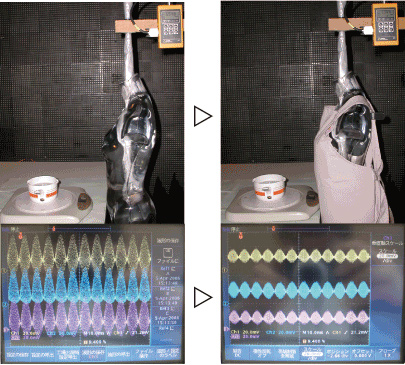
Test conditions
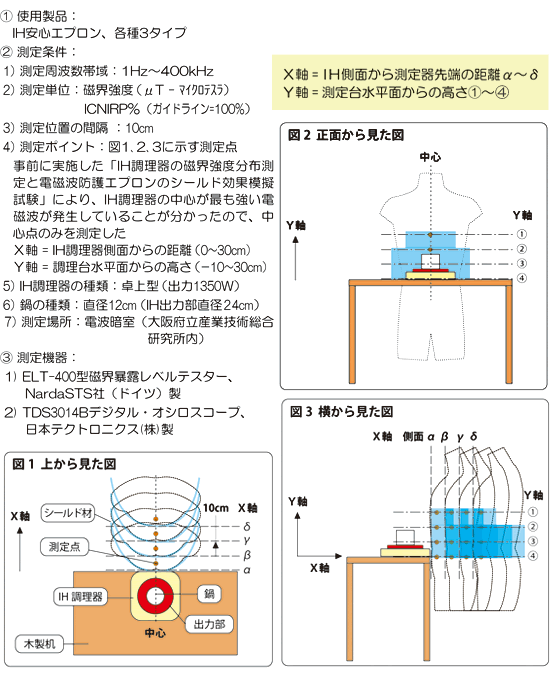
Basis of test data
The International Commission on Non-Ionizing Radiation Protection (ICNIRP) has issued guidelines for human protection, and the European Union (EU) established the EN50366 standard in 2004 as a method for measuring electromagnetic waves from home appliances, etc. Our tests were conducted based on these standards and applied to anthropomorphic dummies.reference:ICNIRP Guidelines (Ministry of Internal Affairs and Communications document)
About ICNIRP…
It is a specialist organization that was established in 1992 as an independent body of the International Radiological Protection Association (IRPA), and is one of the cooperating organizations of the World Health Organization (WHO). It investigates the effects of various types of non-ionizing radiation, and works on creating international guidelines and protection measures.
We evaluated low-frequency magnetic field protection performance by calculating the relative ratio to the ICNIRP guidelines.
The NardaSTS ELT-400 used in the test is the world's first measuring device to implement the ICNIRP time axis evaluation method. Using various IH Anshin Aprons, we measured the magnetic flux density (μT) of the magnetic field generated by an IH cooker in the frequency range of 10Hz to 400kHz, and performed a relative evaluation with the public exposure guideline established by ICNIRP (International Commission on Non-Ionizing Radiation Protection) set at 100%. The EN50366 standard specifies that the measurement distance for an IH cooker is 30cm from the side of the cooking surface, and the measured value is also specified as an effective value, but since our actual cooking distance is mainly around 10cm, we also measured at those distances and measured the peak value defined by ICNIRP instead of the effective value.
As a result, for the IH cooker used in this test, even if the IH Safe Apron was not worn, if the cooker was more than 20cm away from the counter, it was within the guidelines (100%). However, if the cooker was any closer than that, it exceeded the guidelines. If the IH Safe Apron was worn, the cooker was able to comply with the guidelines almost completely even if the cooker was within 10cm.(belowRed highlighted area in tableexceeds the ICNIRP guidelines. ※The ICNIRP% shown here is the result (magnetic flux density) obtained using the above measurement method, expressed as a percentage using the ICNIRP calculation method.
① Height from horizontal surface of kitchen counter30cm
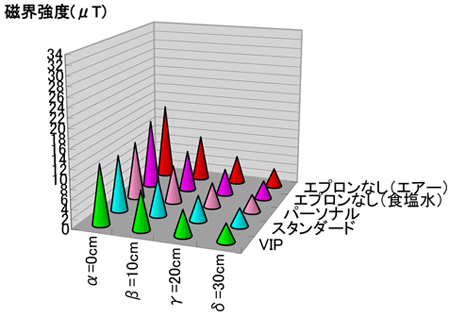
| Distance to induction cooker | α=0cm | β=10cm | Eγ=20cm | δ=30cm |
|---|---|---|---|---|
| ■VIP | 12.4(127) | 8.1(80) | 5.3(51) | 3.7(33) |
| ■Standard | 11.6(119) | 7.8(78) | 5.2(50) | 3.7(34) |
| ■Personal | 12(120) | 7.8(76) | 5.1(49) | 3.6(32) |
| ■No apron (salt water) | 14.4(134) | 8.5(78) | 5.4(48) | 3.8(32) |
| ■No apron (air) | 15.7(146) | 9.5(86) | 5.8(52) | 3.9(34) |
unit:μT(%)
②Height from horizontal surface of counter20cm
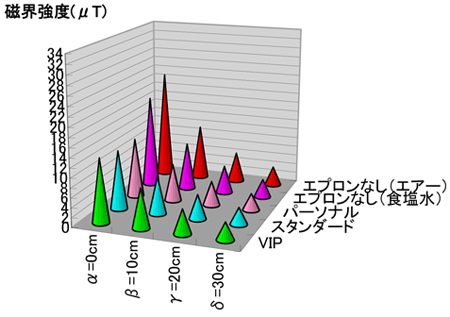
| Distance to induction cooker | α=0cm | β=10cm | Eγ=20cm | δ=30cm |
|---|---|---|---|---|
| ■VIP | 13.3(142) | 8.2(85) | 5.1(51) | 3.6(34) |
| ■Standard | 12.3(135) | 7.8(81) | 5.1(51) | 3.5(33) |
| ■Personal | 12.4(129) | 7.8(79) | 5.1(49) | 3.5(33) |
| ■No apron (salt water) | 19.3(183) | 9.9(93) | 5.8(53) | 3.8(34) |
| ■No apron (air) | 22.8(218) | 11.5(108) | 6.3(59) | 4(37) |
unit:μT(%)
③Height from horizontal surface of counter10cm
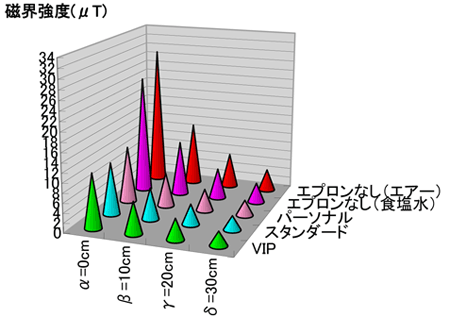
| Distance to induction cooker | α=0cm | β=10cm | Eγ=20cm | δ=30cm |
|---|---|---|---|---|
| ■VIP | 11.3(122) | 6.6(70) | 4.3(42) | 2.9(28) |
| ■Standard | 10.8(120) | 6.5(69) | 4.2(42) | 2.9(28) |
| ■Personal | 11.7(121) | 7(70) | 4.5(44) | 3.2(29) |
| ■No apron (salt water) | 24.5(241) | 11.3(108) | 6.3(59) | 4.1(36) |
| ■No apron (air) | 28.9(286) | 13(125) | 7.1(66) | 4.5(40) |
unit:μT(%)
④Height from horizontal surface of counter0cm
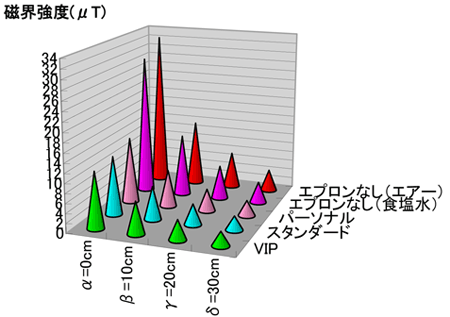
| Distance to induction cooker | α=0cm | β=10cm | Eγ=20cm | δ=30cm |
|---|---|---|---|---|
| ■VIP | 11.7(129) | 6.7(70) | 4.1(42) | 2.9(27) |
| ■Standard | 12.2(132) | 6.9(70) | 4.3(42) | 2.9(27) |
| ■Personal | 13.7(147) | 7.7(78) | 4.6(45) | 3.2(29) |
| ■No apron (salt water) | 28.9(282) | 12.8(121) | 7(65) | 4.4(40) |
| ■No apron (air) | 32.2(315) | 13.6(130) | 7.5(70) | 4.7(42) |
unit:μT(%)
I. Results of low-frequency electromagnetic wave protection measurements
From the above measurement data, we can see that the induced current generated in the body by magnetic fields is large in the abdomen. The IH Safe Apron is designed to cover mainly the abdomen. The IARC (International Agency for Research on Cancer) lists these extremely low frequency magnetic fields as Category 2B (possibly carcinogenic to humans). Also, even if you wear our IH Safe Apron, if you come into close contact with an IH cooker, it will exceed the ICNIRP guidelines, so it is best to stay as close as possible to 10 cm away.
Similar tests were conducted with other commercially available electromagnetic wave protection products, but they did not provide protection against low-frequency magnetic fields*. The IH Anshin Apron is the world's first commercially available product that successfully protects against electromagnetic waves from induction cookers. *Although the OA apron is labeled as blocking low-frequency electric fields, the World Health Organization (WHO) has reported that low-output, low-frequency electric fields emitted by OA equipment have no effect on the human body. We believe that products that do not provide electromagnetic wave protection (not only OA aprons, but also products with stickers or chips attached, etc.) cannot demonstrate electromagnetic wave protection effects on the human body using measurement methods that comply with ICNIRP guidelines.
Data presented at a medical conference by Medical Aid Co., Ltd., the developer
Our company presented its findings at the 20th Annual Meeting of the Japanese Society of Cardiac Pacing and Electrophysiology (now the Japanese Heart Rhythm Society) on May 31, 2005, and has since presented at numerous other academic conferences and symposiums, receiving due recognition in the scientific and medical fields.Reference: Academic presentations, etc.

